Universe 25 – 1972 Mouse Utopia – The Experiment that Ends Humanity – Are we in Universe 25 Now?
Are we living in a Universe 25? The similarities are uncanny.
The "Universe 25" experiment is one of the most terrifying experiments in the history of science.
It is an experiment in which one would believe a Utopia is created. Where food, water and mates were constantly available.
John Calhoun, through the behavior of a colony of mice, is an attempt by scientists to explain human societies.
The idea of “Universe 25" Came from the American scientist John Calhoun in 1972. He created an "ideal world" in which hundreds of mice would live and reproduce. A
A Paradise City for the Mice.
Calhoun built the so-called "Paradise of Mice", a specially designed space where rodents had Abundance of food and water, as well as a large living space.
In the beginning, he placed four pairs of mice that in a short time began to reproduce, resulting in their population growing rapidly.
However, after 315 days their reproduction began to decrease significantly. When the number of rodents reached 600, a hierarchy was formed between them and then the so-called "wretches" appeared.
The larger rodents began to attack the group, with the result that many males begin to "collapse" psychologically.
As a result, the females did not protect themselves and in turn became aggressive towards their young.
As time went on, the females showed more and more aggressive behavior, isolation elements and lack of reproductive mood.
There was a low birth rate and, at the same time, an increase in mortality in younger rodents.
Then, a new class of male rodents appeared, the so-called "beautiful mice".
They refused to mate with the females or to "fight" for their space.
All they cared about was food and sleep. At one point, "beautiful males" and "isolated females" made up the majority of the population.
According to Calhoun, the death phase consisted of two stages: the "first death" and "second death."
The former was characterized by the loss of purpose in life beyond mere existence — no desire to mate, raise young or establish a role within society.
As time went on, juvenile mortality reached 100% and reproduction reached zero.
Among the endangered mice, homosexuality was observed and, at the same time, cannibalism increased, despite the fact that there was plenty of food.
Two years after the start of the experiment, the last baby of the colony was born. By 1973, he had killed the last mouse in the Universe 25.
John Calhoun repeated the same experiment 25 more times, and each time the result was the same.
Calhoun's scientific work has been used as a model for interpreting social collapse, and his research serves as a focal point for the study of urban sociology.
We are currently witnessing direct parallels in today’s society, weak, feminized men with little to no skills and no protection instincts, and overly agitated and aggressive females with no maternal instincts.
-----------------------------------------------------------------------------------------------------------------------
Transcript of this Video:
In 1972, animal behaviorist John Calhoun built a mouse paradise with beautiful buildings and limitless food.
He introduced eight mice to the population. Two years later, the mice had created their own apocalypse.
Here's why.
Universe 25 was a giant box designed to be a rodent utopia. The trouble was, this utopia did not have a benevolent creator. John B. Calhoun had designed quite a few mouse environments before he got to the 25th one, and didn't expect to be watching a happy story. Divided into "main squares" and then subdivided into levels, with ramps going up to "apartments," the place looked great, and was always kept stocked with food, but its inhabitants were doomed from the get-go.
Universe 25 started out with eight mice, four males and four females. By day 560, the mouse population reached 2,200, and then steadily declined back down to unrecoverable extinction.
At the peak population, most mice spent every living second in the company of hundreds of other mice. They gathered in the main squares, waiting to be fed and occasionally attacking each other. Few females carried pregnancies to term, and the ones that did seemed to simply forget about their babies.
They'd move half their litter away from danger and forget the rest. Sometimes they'd drop and abandon a baby while they were carrying it. The few secluded spaces housed a population Calhoun called, "the beautiful ones." Generally guarded by one male, the females—- and few males — inside the space didn't breed or fight or do anything but eat and groom and sleep.
When the population started declining the beautiful ones were spared from violence and death, but had completely lost touch with social behaviors, including having sex or caring for their young.
In 1972, with the baby boomers coming of age in a ever-more-crowded world and reports of riots in the cities, Universe 25 looked like a Malthusian nightmare. It even acquired its own catchy name, "The Behavioral Sink."
If starvation didn't kill everyone, people would destroy themselves. The best option was to flee to the country or the suburbs, where people had space and life was peaceful and natural.
Today, the experiment remains frightening, but the nature of the fear has changed. A recent study pointed out that Universe 25 was not, if looked at as a whole, too overcrowded.
Pens, or "apartments" at the very end of each hallway had only one entrance and exit, making them easy to guard. This allowed more aggressive territorial males to limit the number mice in that pen, overcrowding the rest of the world, while isolating the few "beautiful ones" who lived there from normal society. Instead of a population problem, one could argue that Universe 25 had a fair distribution problem. The fact remains that it had a problem, and one that eventually led to its destruction.
If this behavior is shared by both mice and humans, can we escape Universe 25's fate?
Source: DentHistory -- https://www.youtube.com/watch?v=QYN3110A9L8
End. 1/5/2024.
-
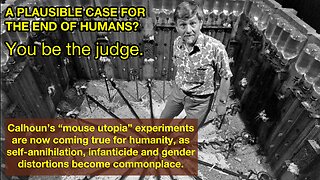 1:51:09
1:51:09
RAVries
1 year agoA Plausible Case For The End of Humans? You be the judge -- Calhoun’s “mouse utopia” experiments are now coming true for humanity as self-annihilation, infanticide and gender distortions become commonplace
954 -
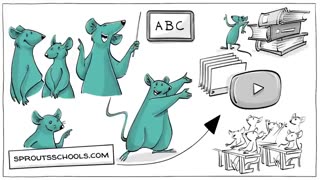 6:07
6:07
Patriot Vibes 1Q7
10 months agoThe Universe 25 Mouse Experiment
42 -
 1:51:09
1:51:09
Health Ranger Report
1 year agoSituation Update, 11/28/22 - The Calhoun "mouse utopia" experiment...
6.24K37 -
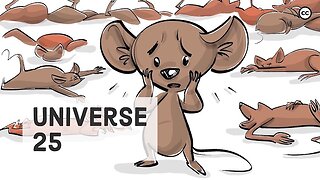 6:07
6:07
Sprouts
1 year agoThe Universe 25 Mouse Experiments
8502 -
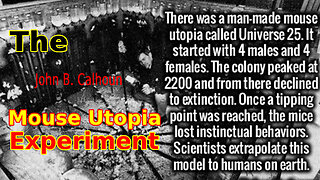 24:42
24:42
ADVANCED CIVILIZATION
1 year agoThe (John B. Calhoun) Mouse Utopia Experiments
115 -
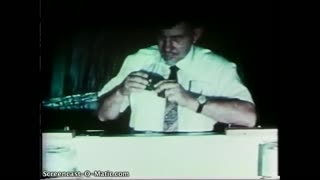 8:22
8:22
Bound for Glory
1 year agoUniverse 25- John Calhoun's NIMH Experiment
1801 -
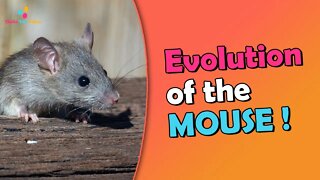 1:31
1:31
Three Tea Trees
1 year agoThe Story of The First Mouse on Earth
22 -
 2:43
2:43
DJ6ual: An Irish Girl's Channel
8 months agoBrave New World: A Dystopian Future Unveiled
29 -
 12:25
12:25
The Lotus Eaters
1 year agoThe Potential Flaws of the Mouse Utopia Experiment
1.07K5 -
 39:45
39:45
Awaken Bible Prophecy
1 year agoAwaken Bible Prophecy Update 12-21-22: Utopian Extinction - Of Mice & Men
6928